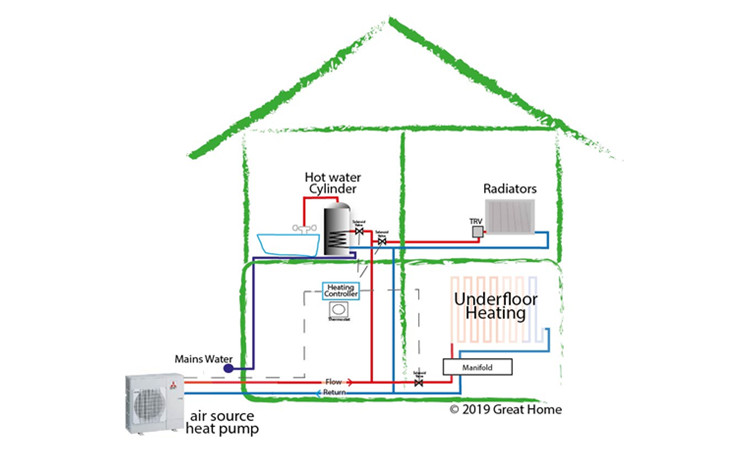Air Source Heat Pump Heating Design
An air source heat pump (ASHP) is an all-electric solution that uses a reversing valve to allow the HVAC unit to operate in both cooling and heating states by reversing the refrigeration cycle and capturing the heat from the compressor to heat the space served by the unit.
Designing HVAC systems with ASHPs has become a common choice for building designers and owners due to a number of factors.
* Energy efficiency
* Local codes
* Low carbon footprint
* Natural gas alternative
Given all of these advantages, designing an HVAC system with ASHP capabilities seems like the right choice for many buildings. However, heating applications of these units can be a challenge—and not just in sub-zero climates. To achieve and maintain the desired space temperature, the ASHP must deliver exhaust air in a reliable and consistent manner. This may seem simple, but the reality is that many factors can get in the way when in heating mode. Extreme temperatures can cause HVAC units to shut down. Cold, moist outdoor air will trigger the need to defrost the outdoor coil, which will direct all or part of the compressor's heat onto the frosted coil and away from the building occupants. Optimizing equipment design can help avoid these pitfalls.

Selecting Energy Recovery
Combining an air source heat pump with energy recovery can extend the operating range of the unit, which is especially important in cold climates when introducing large amounts of outdoor air. To ensure the compressor can start and operate within the operating range, the air temperature approaching the coil must be at or above 30 °F. An energy recovery device can mix warm exhaust air with cool/cold incoming outdoor air to condition the air approaching the indoor coil, extending equipment operating time and reducing energy costs.
Many energy recovery technologies exist, and choosing the right technology for the application often depends on the primary drivers of the building. If there are no on-site staff, then a unit with no moving parts (such as an enthalpy core) may be the best choice. If energy efficiency is paramount, then an enthalpy wheel may be the right solution. Regenerative heat exchangers are up to 95% efficient and can have a dramatic impact on the amount of heat required to maintain space conditions. For ASHP applications, select a technology that optimizes heating performance.
Understanding the Defrost Cycle
ASHPs have an inherent application challenge in that frost can build up on the outdoor (evaporative) coil when the unit is in heating mode. Frost buildup can reduce the system's heating performance, requiring a defrost cycle to remove the frost and allow the coils to operate at maximum efficiency. When the unit is in defrost mode, the compressor's heat is redirected away from distributing warm air to the space and instead directed to the outdoor coil to melt the frost. This can result in little to no heat being directed to the space. The end result can be that the space starts to cool, many times below the desired set point. Two ways to address this challenge are to reduce the frequency and duration of defrost cycles or to design the unit with multiple circuits that allow the unit to direct heat toward both defrost and space comfort.
To reduce the risk of the unit going into defrost unnecessarily, the defrost sequence should be initiated based on the correct data. Some HVAC unit controllers use outdoor air temperature as a trigger. However, the reality is that the outdoor air dew point is actually a better indicator of the potential for frost. Cool (i.e., 40 °F), foggy air on the ASHP unit's outdoor coil will quickly produce frost. Conversely, cold (0 °F) weather with little to no moisture in the air may not produce frost conditions.
To design an ASHP that maximizes normal operation in heating mode, designers should understand what triggers defrost, how long the defrost cycle lasts, and how the unit exits defrost mode. Look for measured inputs based on outdoor air dew point and saturated suction temperature as the best indicators that frost is indeed present on the outdoor coil. Once the saturated suction temperature returns to the set point, or a maximum time (in minutes) has passed, the unit can stop defrosting and resume normal operation.
Another effective way to avoid unit downtime during defrost is to select a unit with multiple circuits. This allows heat from one circuit to be used for defrost while the remaining circuits continue to provide heat to the space.





